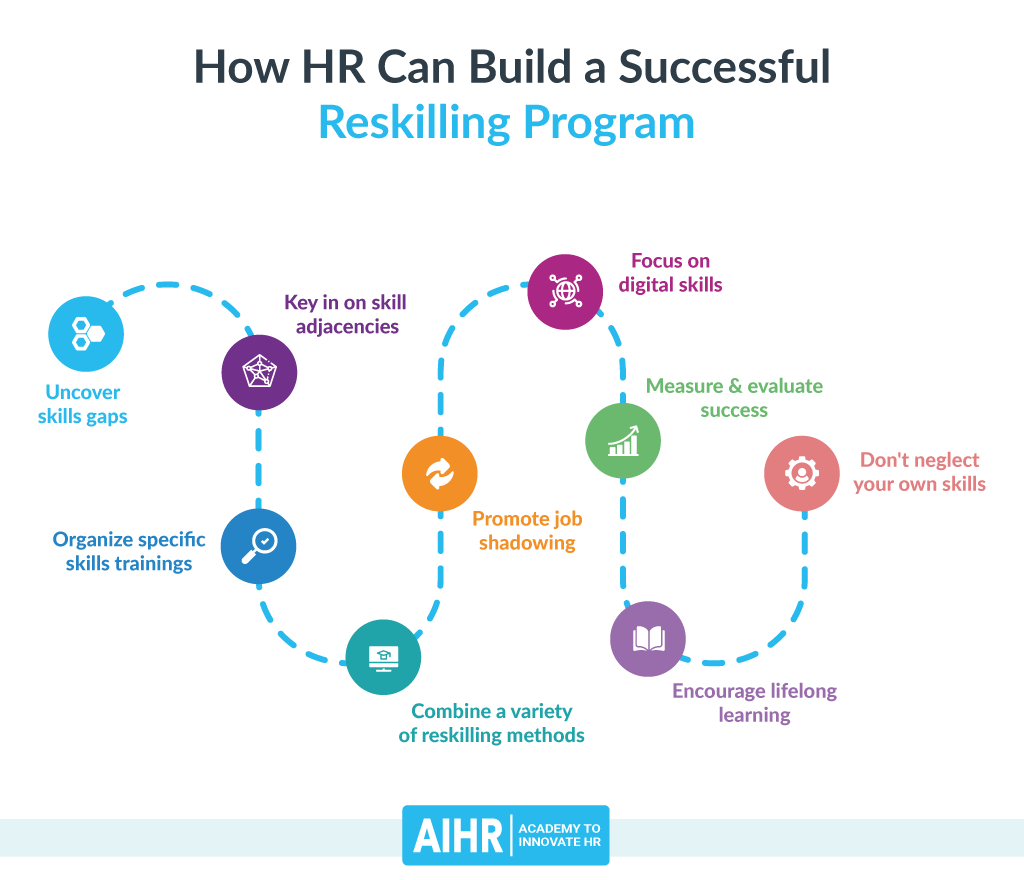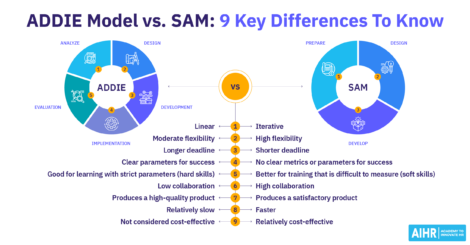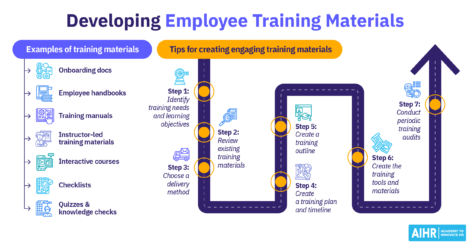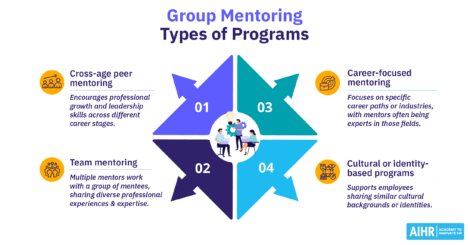Reskilling Your Workforce for the Future: An HR’s Guide

If your organization wants to stay competitive, you must have employees with the right skills to help you be productive, innovative, and ultimately more profitable. Reskilling is a way to ensure your employees have the skills they need to thrive and make transitions into new roles. Read on to learn more about reskilling and how to successfully reskill your workforce.
Contents
What is reskilling
Why is reskilling important?
What are the benefits of reskilling your employees?
How can your organization build a successful reskilling program?
What is reskilling?
Although the terms “reskilling” and “upskilling” are sometimes used interchangeably, and they often go hand in hand, they are separate concepts. Reskilling is training employees in new capabilities to equip them for a different position within the organization. Upskilling is preparing employees for major changes in their current position. Organizations often employ both reskilling and upskilling strategies to enable internal mobility and prepare their workforces for the future.
Emerging technologies are entirely reshaping industries and require that people have specialized skills. Many companies face discrepancies with their employees’ current expertise and what will be required in the coming years. A 2020 McKinsey & Company survey discovered that the financial services, telecom, and high tech industries will face the most disruption from skills gaps. The essential skills they will need are dependent on mathematical and advanced data-analysis abilities.
Reskilling workers is an effective way to address this dilemma. Employers have the prospect of retaining those who seek learning opportunities and being able to fill open positions from within.
E-commerce giant Amazon embraced the reskilling concept for its warehouse workers who were being phased out by automation. In 2019, it invested $700 million for developing their technical skills to take on new positions in IT support and software engineering.
Ernst & Young, the London-based multinational professional services network, has committed $450 million to employee learning. In addition to mandatory trainings for accounting and auditing roles, a portion of the funds go to a program that allows employees to customize their own continuing education.
Why is reskilling important?
The pace of technology has created a significant transition in how business is conducted worldwide, and the future of work is hard to predict. The distinctions between technology and the real world are blurring, and this progression has been named the Fourth Industrial Revolution.
Cyber-physical systems now make up the indispensable products and services that humans expect and rely on, such as voice-activated virtual assistants and photo facial recognition. Because of this transformation, new occupations are being created, and some are becoming obsolete. This leads to the question, how many workers need reskilling? According to a McKinsey Global Institute report, “By 2030, … as many as 375 million workers—or roughly 14 percent of the global workforce—may need to switch occupational categories.”
Reskilling helps manage change and navigate future workforce planning efforts by retraining your workforce for what lies ahead and putting employees’ talents to use in crucial new roles.
Discover the 9 steps to reskill your workforce for the future in this Learning Bite!
What are the benefits of reskilling your employees?
Let’s look into the advantages of reskilling in more detail.
Improving employee retention
The current job market is highly competitive. Now that job-hopping is an acceptable, if not necessary, way to advance a career, employers need to provide ample development opportunities to keep people on board.
The ability to learn and grown in a position helps employees stay focused on their current employer instead of contemplating new prospects. Investing in skills training shows workers that they have present and future value within the company.
Reducing the cost of filling new roles
It’s no secret that recruiting expenses and lost productivity affect your company’s bottom line. Filling openings internally helps reduce these costs.
Reskilling increases employees’ value by preparing them for an alternative role. When a new position becomes necessary, someone will have the skills needed to step in and keep operations running smoothly.
Attracting new talent with a growth mindset
A Gallup report revealed that 59% of Millennials rank learning and growth opportunities as extremely important to them when looking for a job. Your organization’s dedication to improving employees’ skills can be an advantage for sourcing and hiring motivated applicants.
Your current employees who appreciate the benefit of a reskilling culture will also fortify your employee brand when they speak highly of their experience. Their positive feedback can result in referring desirable candidates to apply for your open positions.
Supporting employee engagement
A collaborative environment prevents the disengagement that happens when employees feel left behind. When employees have the means to develop their skills, they can expand their expertise to new areas and feel more connected to other departments. Understanding the different skill sets required in other areas promotes empathy and comradery instead of an “us versus them” competitive mentality.
Reskilling opportunities are also steps forward on a career path to provide your personnel with new talents. What’s more, you’re giving them a vision for growing and advancing within your organization.
Boosting employees’ confidence and morale
Those who are confident in their skills and abilities propel productivity and innovation. They are prone to be proactive, voice new ideas, and devise creative solutions to problems. One study done in 2020 showed that 80% of employees believe their confidence improved from reskilling training.
Building confidence in certain employees can tap into underutilized talent. Introverts or those who fall into underrepresented groups may be overlooked but will often have much to offer when they feel assured in their abilities. New capabilities can also increase morale as people feel more valuable to the company.
How can your organization build a successful reskilling program?
A strong reskilling program closes skills gaps to support your workforce and the organization, and it often integrates with an upskilling program. Usually, it is a company-wide effort in which HR plays a key role.
You can use the following nine steps to maximize the effectiveness of your reskilling program:
1. Uncover skills gaps
Once you map out where your business is headed and what it takes to get there, you need to assess how well your current roles and workforce are equipped to support this. You’ll need a balance between available abilities and what every position requires.
An updated skills inventory of what your employees have to offer can reveal secondary and tertiary skills. You can use it in conjunction with a skills gap analysis. It will help you determine the specific skills and knowledge your workforce is missing.
2. Key in on skill adjacencies
Once you have identified the critical skills needed, you should look for adjacent abilities, or “skills closely matched to those in demand,” to make reskilling a little easier. Employees with related competencies may already have what’s necessary or can quickly learn what they would need for a new role.
For example, someone with customer/client service experience can make a smooth transition into sales. That’s because they have strong verbal communication skills and first-hand knowledge of your product or service.
With the growing popularity of online banking, banks in Singapore are reskilling their frontline staff to be able to work in customer contact centers.
3. Organize specific skills trainings
Once you understand which skills in which departments you need to develop, you can determine the exact trainings required for your employees to develop the new skills.
You may also want to consider incentives to reward those willing to expand their abilities. Make it clear that reskilling is linked to new prospects or advancement within the company. Then, your employees will be more motivated to participate.
Since there will be variance within your employees’ skillsets, trainings will need to be somewhat personalized to meet different learning needs. Offering an assortment of training methods is ideal. (See #4 below.) Your current learning platform may not be sufficient for certain types of reskilling, so it could be time to invest in other resources.
Internal company bootcamps are an example of how organizations reskill employees from nontech roles into developers. These people are then able to tackle company-specific challenges.
4. Combine a variety of reskilling methods
You should have several education delivery techniques in place to ensure there is flexibility and options that work best for different learning styles and the type of skill gap that you’re aiming to address. The more training occasions and methods you offer, the higher participation will be.
Examples of these methods include:
- On-the-job training – Employees can have real-world exposure to the tasks of a new role by taking on small projects for another team or through a mentoring relationship.
- Online learning – Online courses are beneficial because they are accessible anytime and anywhere to speed up the learning process. Bite-sized learning is advantageous because it concentrates on the specific information needed to achieve a learning objective. It’s also easy for all types of learners to grasp.
- Blended learning – Combining online learning with classroom training assures that all material is covered. It also provides the opportunity for learners to ask questions and interact with an instructor.
- Peer learning – Employees can learn from each other when they collaborate and reflect on real-world scenarios or hands-on practice of new tasks.
If your organization has remote or hybrid employees, you can’t neglect to apply remote training methods to reskill this sector of your workforce.
5. Promote job shadowing
Job shadowing is an excellent way for people to get familiar with a new role within or across departments. Following and observing an experienced employee throughout their day gives an accurate portrayal of the job requirements. In essence, job shadowing helps better prepare someone to take on a new position.
It is also a great reskilling method if you’re on a tighter budget.
6. Focus on digital skills
Companies that were forced to have employees work from home during the pandemic quickly learned how integral technology is to business and how vital adequate digital skills are. Digital advancement is an ongoing reality, so businesses must prepare their employees to adapt to new technologies.
Training people and preparing them to use new tools must continue to close the digital skills gap. Your reskilling program should prepare your workforce for the forthcoming digital transformations.
7. Measure and evaluate success
There is no point in a reskilling program unless it’s effective, so you should measure the impact of your efforts. Are your employees applying the new skills? Are they able to transition into new roles?
Measuring training effectiveness starts with collecting data from various sources, including surveys, discussions, and post-training assessments. Then you can assess the data using an evaluation model.
The well-known Kirkpatrick’s Four-Level Training Evaluation Model uses learners’ reactions and responses, knowledge, and skills obtained, behavioral changes made, and the impact on business goals to measure the extent of a training program’s influence.
Once you know how well your reskilling program is working, you can use its strengths or weaknesses to make improvements.
8. Encourage lifelong learning
Reskilling is a perpetual process, so your organization needs to offer a continuous learning culture. You can instill a knowledge-seeking mindset in your employees by encouraging them to embrace reskilling opportunities. Offer support to find the suitable methods that work for them.
Managers must buy-in to the value of reskilling, and they should actively participate in their own trainings. Make sure leadership understands the importance of developing their staff, so they will whole-heartedly promote your reskilling program.
9. Don’t neglect your own skills
HR is changing rapidly too, so new skills are required to stay current. As an HR professional, you also need to focus on your own development, and starting your reskilling (and upskilling) program in your department makes sense.
Upgrading your abilities with advanced HR technologies and people analytics will give you and your company an edge going forward.
Spelling it out
Reskilling is an essential strategy to fill skills gaps and ensure that your employees are well equipped to contribute to your organization’s goals and mission. Understanding where your company is headed and what skills will be required is key to building a successful reskilling program.
This mutually beneficial endeavor provides job security and growth for employees and stronger workforce retention for your business.
If you want to become an expert in learning & development and future-proof your HR skill set, check out our Learning & Development Certification Program!
Weekly update
Stay up-to-date with the latest news, trends, and resources in HR
Learn more
Related articles
Are you ready for the future of HR?
Learn modern and relevant HR skills, online












